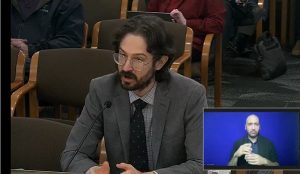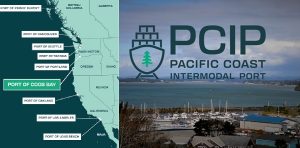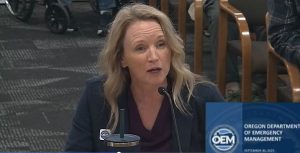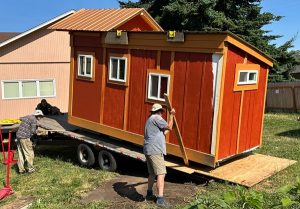Scientist raises ethical concerns about Oregon global warming report
10 min read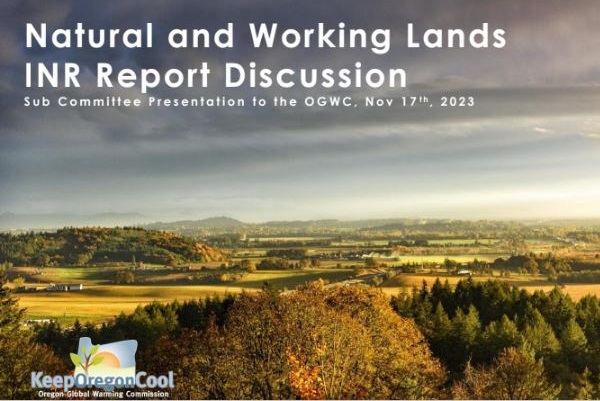
On Nov. 17, public comments at the Oregon Global Warming Commission. A key technical contributor speaks out against the Natural and Working Lands Report for ‘scientific and ethical reasons.’
[00:00:12] Dr. Mike Badzmierowski: My name is Dr. Mike Badzmierowski. I was the lead agriculture land use technical lead and a lead author for the technical portion related to practices and metrics of this final report. I did this work while I was a soil health specialist at the Oregon Department of Agriculture.
[00:00:29] I received my doctoral degree in soil carbon and nitrogen research along with associated greenhouse gas emissions in agriculture. I have also trained in assessing data quality related to these topics during my postdoctoral research. I now serve as the U.S. agricultural policy manager at the World Resources Institute, where I am to use my expertise to guide U.S. funding towards agricultural practices that meaningfully reduce greenhouse gas emissions in agriculture.
[00:00:56] Most agricultural emissions are from enteric emissions, primarily from cattle, manure, and nitrogen fertilizers. Without addressing these big three, greenhouse gas emissions will not meaningfully be reduced in agriculture.
[00:01:10] I would like to just put in a little note that the process figure that was presented today that showed the INR (Institute for Natural Resources) process facilitation did not include two names, Dr. Rose Graves and myself, both of which were key figures in this technical portion of this final report.
[00:01:25] I strongly do not support this current version of the final report based on scientific and ethical reasons, and would suggest that this be used as a first step towards a living set of eligible practices and related metrics that gets continuously updated with increased data availability.
[00:01:42] John Q: He said the issue arose over a practice recommendation from the agriculture land use technical team.
[00:01:50] Dr. Mike Badzmierowski: ‘Promote, incentivize and adopt diet shifts of Oregonians towards lower greenhouse gas commodities and create demand for Oregon farmers to grow commodities with a reduced greenhouse gas footprint.’ I was mandated at the last minute to change the wording of this practice. Otherwise, it would be removed entirely.
[00:02:08] This clearly became a political discussion, rather than a scientific discussion, despite the agreement that the technical document would remain scientific-based and provide practices across all land uses that the technical team was confident would lead to net carbon sequestration. Without this practice, agriculture and society will most likely not meet its goals in keeping warming below two degrees Celsius.
[00:02:30] John Q: He also said his team’s final version was not shared in the report.
[00:02:34] Dr. Mike Badzmierowski: The final report does not use the final version created by the agricultural land use team after repeated attempts to fix this issue. For example, it does not include the practice of reducing food loss and waste. This also includes the lack of inclusion of an 11-page response to the stakeholder advisory committee that provided extensive rationale on why certain practices were not included in the agricultural technical recommendations.
[00:03:00] I am confident that my opinion is not alone on these highlights.
[00:03:03] John Q: With a second shout-out to Dr. Rose Graves, The Nature Conservancy‘s Laura Tabor.
[00:03:08] Laura Tabor (Nature Conservancy): My name is Laura Tabor. I’m the climate action director with The Nature Conservancy in Oregon.
[00:03:15] I want to start by thanking the commission for taking on this work. It’s a big and complicated sector and so the work over the past year represents a lot of effort and commitment and I think has also given us at least a good starting place to start working on implementation of the natural climate solution sections of House Bill 3409. The natural working land sector is one where addressing climate change mitigation and addressing climate change adaptation and resilience can be deeply intertwined.
[00:03:44] Both of these things are important, but we also need to have clarity on which programs are focused on one, the other, or both. We want to help natural working lands rise to the occasion of meeting proposed greenhouse gas sequestration goals and we want to be able to help landowners and managers adapt to and be resilient in the face of an already-changing climate.
[00:04:07] House Bill 3409 does define natural climate solutions as explicitly having a greenhouse gas mitigation component. The legislation also directs agencies in the implementation and incentivizing of natural climate solutions to optimize for a number of other factors, including climate resilience and ecological benefits.
[00:04:29] So, I think one of the shortcomings of the process over the past year was a lack of clarity on how to achieve this balance and what the focus of the work should be. And I think that that’s led to a lot of the difficulties of the process and different approaches among the technical sector groups as well as some of the tension between the technical and stakeholder advisory groups.
[00:04:54] We do think that there is still great opportunity to implement this new legislation in a way that’s both carbon- and resilience-forward and benefits communities. And this is going to take a significant amount of work, both in clarifying the nuances of the specific practices listed in the document, and in working towards a portfolio across and within sectors that achieves the right balance of reaching these goals.
[00:05:20] I did want to highlight in particular one practice that is a high priority for us at TNC. We noticed that riparian reforestation, while it was in Table 2 in the report, did not make it into the executive summary or Figure 5, at least not explicitly in terms of the list of recommended practices.
[00:05:44] And some of you may recall that my colleague Dr. Rose Graves‘s research on natural climate solutions practices in Oregon found that this practice is the second-highest potential for carbon sequestration across Oregon. It’s also a practice with significant ecological and social benefits. So, wanted to, in particular, call attention to the absence of that practice in the final list and hopefully, maybe that was an oversight or maybe there was an understanding that it was duplicative, but we’d really like to see that practice called out specifically.
[00:06:19] John Q: Two Audubon Society members encouraged adoption of blue carbon practices.
[00:06:25] Kent Doughty (Audubon Society of Lincoln City): My name is Kent Doughty…speaking today on behalf of the Audobon Society of Lincoln City (ASLC). Our mission is to encourage residents and visitors to protect and enjoy native birds, other wildlife and habitats found along the central Oregon coast.
[00:06:42] Conservation and restoration of blue carbon habitats can address both the climate and biodiversity crises as well as support local economies, culture, lifeways and, yes, protect the birds and habitats that our organization so deeply cares about.
[00:07:00] I’m here to encourage the commission to be bold in its recommendations by adopting all the blue carbon practices described in the NWL (Natural and Working Lands) report…
[00:07:09] Over the last three years, the commission has acknowledged and elevated the important role that natural and working lands play in addressing the climate crisis. The inclusion of conservation and restoration of tidal wetlands as well as seagrass conservation as practices to store carbon will help meet climate mitigation goals, support protection of these extraordinary natural habitats, and help buffer against climate impacts, like increased storm surge and sea level rise.
[00:07:40] Lincoln City Audubon and an array of other groups have been working with local governments to update the Yaquina Bay Estuary Management Plan. While most of the tidal wetlands in Yaquina Bay have been lost, there are still many high-quality tidal wetlands that support a rich diversity in stored carbon, including tidal wetlands in the blue carbon inventory. Adopting the recommended blue carbon practices helps local on-the-ground efforts to build climate change resiliency and take advantage of the current federal funding availability.
[00:08:12] The final NWL report describes specific practices and methods to quantify the benefits of the recommended practices. We encourage the commission to create a regular schedule to incorporate these emerging practices, or even new practices as wetland carbon science continues to improve and habitat extent changes—blue carbon emerging practices for kelp restoration as an example—that fit well with many of the activities that Lincoln City ought to be pursuing in terms of protecting rocky habitats.
[00:08:46] Paul Engelmeyer (Ten Mile Creek Sanctuary): My name is Paul Engelmeyer. I manage land, the Ten Mile Creek Sanctuary for Portland Audubon. The sanctuary is located on the central coast and is at the heart of a marbled murrelet globally significant important bird area of approximately 80,000 acres, which includes the Cape Perpetua marine reserve and seabird protected area…
[00:09:07] I would like to highlight the importance of continue to prioritize blue carbon habitats as natural working lands, particularly within the framework of Oregon’s many estuaries. As you are aware, Oregon’s over 20 estuaries support important blue carbon habitats, mud flats, eelgrass, tidal forested wetlands that are incredibly important for carbon sequestration, rivaling old-growth forest, and also supporting thousands of migratory birds, waterfowl, shorebirds, and wading birds, and vital stopover in the Pacific Flyway.
[00:09:40] Seventeen of these estuaries in Oregon are recognized as IBAs (Important Bird Areas). Oregon’s estuaries, blue carbon habitats, are also important for commercial important fisheries as vital nursery grounds for juvenile fish and shellfish. As you also are aware, Oregon is updating the estuary management plans. I’ve been a part of that, of a team working on the Yaquina Estuary Management Plan. And it’s critical that we highlight the importance of protecting blue carbon in this process.
[00:10:10] And I’m also encouraged to see findings about the INR report recommending tidal wetland conservation. Tidal wetland restoration/seagrass conservation are key components to protect and restore blue carbon. We encourage the commission to create a regular schedule to incorporate the emerging practices identified in the INR report.
[00:10:34] And also, I encourage the commission to support facilitating the significant amounts of federal funding for practicing that conservation and restoring blue carbon habitats, spanning federal agencies like USDA, NOAA and EPA, many of these programs support land acquisition, and these agencies are looking for good projects.
[00:10:56] I’m proud to acknowledge that our local Midcoast Watershed Council on the Central Coast has secured a focused investment partnership funding to work in both the Yaquina and Alsea estuaries. I see natural climate solution as one effort that has multiple benefits.
[00:11:13] What you may not be aware of is Oregon’s estuaries and over 112,000 stream miles in Oregon are on the Federal Clean Water Act 303(d) list. They are impaired and in dire need of restoration work and a completed TMDL (Total Maximum Daily Load report). These efforts will be storing carbon as well as improving water quality, a conservation strategy that’s linked to salmon recovery and clean water for our communities. The magnitude of this effort would be described as monumental.
[00:11:46] We have an opportunity right now to put forward a comprehensive plan that pulls together current and future coastal conservation restoration projects to best secure these federal funds. We need to act now to secure these federal funds that won’t last forever.
[00:12:02] We ask the commission to help fill the science and data gaps and concerns about carbon accounting, the flux, freshwater wetlands. There’s still a lot to learn. We need to challenge all of the science behind this and make sure we’re on the right path. Oregon’s coast has extensive freshwater wetlands, a landscape that was not considered for this project, yet still store carbon at rates exceeding other natural habitats.
[00:12:31] John Q: One commenter identified only as ‘Lauren A.’ agreed that the report should not be considered final.
[00:12:36] Oregon Global Warming Commission: Lauren A.
[00:12:37] Lauren A.: This report, I think is a fantastic starting point, but like previous comments, I feel that there’s a lot missing from it, especially in terms of detail… When it comes to forestry practices, it’s important to acknowledge that not all forests in Oregon are tree plantations. Conservation is an incredibly important practice, especially when it comes to old-growth forests. These trees store and sequester a massive amount of carbon across the state and the report failed to acknowledge the conservation of old-growth forests or old-growth forests as a climate strategy.
[00:13:15] The second piece I’d like to call out for the commission is the fact that while wildfire risk reduction is a really critical practice… the state is getting tens of millions of dollars to address this strategy already. And there are multiple committees already focused on this work.
[00:13:32] So I just want to be sure that when we think of the fund, it’s, you know, it’s divided between four state agencies, so it’s basically, you know, $2.5 million per agency and that’s not a lot of money. So it’d be great if that money could be focused on practices and issues that are new and emerging and innovative and there’s not already funding and attention and technical expertise going towards. So, really just thinking outside the box of how these funds are used and ensuring they’re used in a smart and ambitious manner.
[00:14:09] And all, basically every single forestry practice that’s called out in the INR report, is extremely high-level. And I understand that’s because there’s a lot of disagreements around forestry practices and they’re complicated issues. But I want to very much call out for the commission the risk of maladaptation. If these recommendations are too high-level, you run the risk of undermining the climate and ecological biodiversity, clean water values that we’re trying to preserve. So please, please think through those maladaptation considerations as you move forward with these practices.
[00:14:44] John Q: Written comments also identified a major gap in the report. Former stakeholder Margaret Corvi said, ‘I see little reflection of inclusion of tribal practice or direct collaboration with tribal nations.’
[00:14:56] She asked the commission to recognize this gap and develop a plan ‘for incorporating tribal nation land and resource strategies, management and stewardship.’
[00:15:05] At the Global Warming Commission, a key contributor alleges that the technical document was changed for political reasons. Unless we address the big three—cattle, manure, and nitrogen fertilizers—Dr. Mike Badzmierowski says society will likely fail to reduce global warming.
